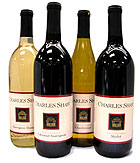From
The Scotsman, in Scotland on Sunday, there's an article about an entrepreneur bringing premium boxed wine to Scotland
Sun 3 Jun 2007
Now wine lovers can think out of the box
WILLIAM LYONS WINE CORRESPONDENT
IT USED to be the scourge of the summer party, reserved for the hoi polloi and definitely not for connoisseurs.
But now a Frenchwoman living in Scotland is aiming to do for boxed wine what Volkswagen did for Skoda, with a new range targeted at just the kind of discerning drinker you would expect to shudder at the very idea.
Valerie Blanc, who worked for Glenmorangie, is hoping to put a box on the dining tables of the most picky connoisseurs with a new company that will sell what is known by wine buffs as 'chateaux-bottled' wine - but in a bag.
She hopes the concept will appeal to eco-friendly wine lovers weary of visiting the bottle bank and restaurants who want to serve customers by the glass.
Her firm, Provenance Boutique Wines, offers a range of wines sourced directly from the vineyards of France.
Packaging and shipment are reduced as the boxes are lighter and cheaper to produce than glass. Hefty merchants' fees are also waived as they are shipped direct from the vineyard.
Improvements in technology mean that the vacuum-packed bags-in-boxes can keep the wine fresh for up to six weeks after opening. Prices start at around £41 for a five-litre box - the equivalent of £6.15 a bottle.
The idea came to Blanc on a visit to her family in Bordeaux. "I went to stay with my parents and they served a delicious red wine," she says. "When I asked my father what it was, he produced a box - I couldn't believe it. But he told me that in France there is a huge market for bag-in-box wine. Over there it doesn't carry the same stigma as it does in the UK.
"When I returned to Scotland, I found that the only wine I could find that was sold bag-in-box was basically cheap plonk or co-operative wine. I thought this is crazy, as in America and Australia it is massive."
Travelling back to Bordeaux, Valerie went in search of a number of small, independent producers, picking a handful from the Loire and Cotes de Blaye.
She also realised the concept would attract interest because it is environmentally-friendly.
"In this country we have a real problem with green bottle recycling. At the moment you have to get in your car and drive to the recycling point," she says.
A recent report by Vinexpo found that the wine industry risks losing a generation of customers if it doesn't get better at capturing the attention of younger drinkers.
The survey found that many young drinkers were curious about wine, but deterred by too many choices and styles, complex labelling and wine's stuffy image.
Nick Room, wine buyer for Waitrose, said the new concept would succeed in the British market.
He said: "They sell well in France, and I see no reason why they couldn't take off over here. The market trend is towards environmental packaging and bag-in-box is the best alternative. It just takes something to convince consumers that the wine in the bag is as good as the wine in the bottle."
But others were less convinced. Neil Beckett, editor of the World Of Fine Wine, described the idea as interesting, but said it would still face resistance from some quarters.
"In terms of viability and integrity of the wine it makes much more sense than it would have done in the past. There used to be great problems with oxidation and contamination. A lot of those issues have been resolved.
"But it is a similar issue to screwcaps, there will always be people who are attached to the romance of using a corkscrew and drawing a cork and the whole of ritual of it."
And Philip Larue, the Scottish director of Friarwood fine wine merchants, thought the concept was ridiculous. He said: "
"I know it is very popular in France but I think this sort of thing should be kept to camping. Wine is all about romance and occasion. To some extent presentation is as important as the quality of the liquid that is in the bottle."
Scotland on Sunday - UK - Now wine lovers can think out of the box
 So, OK, Two-Buck Chuck is not boxed wine, but I'm going to include this item here because I have had so many conversations about Two-Buck Chuck vs premium boxed wines. I must admit, I am stunned. The California State Fair Wine Competition judged the Charles Shaw 2005 California Chardonnay best best of class. This was on yesterday's Business Wire. The news is apparently so fresh that the results are not even up on the State Fair website yet. Here's a segment of the article.
So, OK, Two-Buck Chuck is not boxed wine, but I'm going to include this item here because I have had so many conversations about Two-Buck Chuck vs premium boxed wines. I must admit, I am stunned. The California State Fair Wine Competition judged the Charles Shaw 2005 California Chardonnay best best of class. This was on yesterday's Business Wire. The news is apparently so fresh that the results are not even up on the State Fair website yet. Here's a segment of the article.

